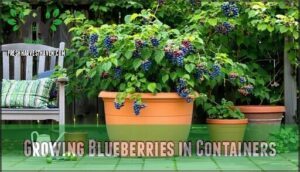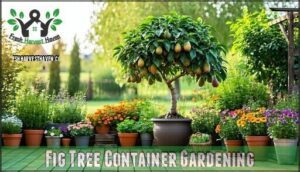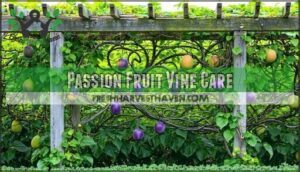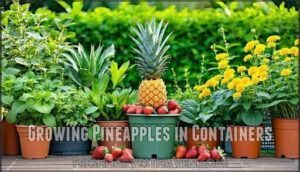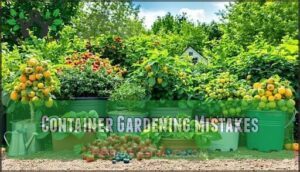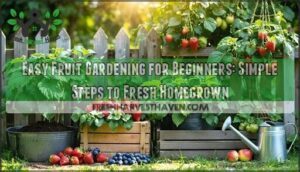This site is supported by our readers. We may earn a commission, at no cost to you, if you purchase through links.

Most fruit trees need 6-8 hours of direct sunlight and well-drained soil to produce their best yields. The secret lies in matching your climate zone with the right varieties and understanding each fruit’s specific watering and pruning needs.
Table Of Contents
- Key Takeaways
- Best Fruits to Grow
- Easy to Grow Fruits
- Fruit Tree Care Tips
- Fast Growing Fruit Options
- Container Gardening Mistakes
- Frequently Asked Questions (FAQs)
- Which fruit tree is best for a new gardener?
- What fruits and berries can you grow in containers?
- What fruits are easy to grow?
- What fruits can you grow in a small space?
- What are the best fruit crops to grow in summer?
- Can you grow fruit trees outside?
- What are the best fruit trees for containers?
- What fruits can you grow in a garden center?
- Which fruit is best for a small space?
- What fruits can I grow in my backyard?
- Conclusion
Key Takeaways
- You’ll get the fastest results with strawberries and dwarf fruit trees, which produce fruit within 2-3 years, while berries like blueberries provide decades of harvests with minimal maintenance.
- Choose apple trees for reliability and berries for quick rewards – they’re forgiving to beginners and adapt to most climates with proper sunlight (6-8 hours daily) and well-draining soil.
- Container growing works perfectly for small spaces using dwarf varieties of peaches, figs, citrus, and berries – just ensure containers are 18+ inches deep with good drainage systems.
- Success depends on matching varieties to your climate zone, proper pruning during dormant seasons, and consistent watering without overwatering to prevent root rot.
Best Fruits to Grow
When you’re starting your fruit-growing journey, focus on varieties that forgive beginner mistakes and produce reliable harvests. Apple trees, berries, and cherries offer the perfect combination of hardiness and rewarding yields for new gardeners.
Apple Trees for Beginners
Apple trees represent the quintessential choice for Apple Tree Planting beginners. Dwarf Varieties like ‘Gala,’ ‘Fuji,’ and ‘Honeycrisp’ reach manageable heights of 8-15 feet, making harvest and maintenance achievable for new growers.
These hardy varieties adapt to most climates while delivering reliable harvests year after year.
Plant your Apple Trees in well-drained soil with 6-8 hours of daily sunlight. Most varieties require cross-pollination, so plant two different cultivars within 50 feet of each other for ideal Fruit Yield Maximization.
Beginner Pruning involves removing dead branches and maintaining central leader structure during the dormant season. Tree Support Systems prevent wind damage in young trees. Disease-resistant varieties like ‘Liberty’ reduce spray requirements while ensuring successful backyard fruit gardening. With proper fruit tree care, mature trees yield 480-690 pounds annually—transforming your garden into a productive orchard paradise.
Benefits of Growing Berries
While apple trees offer reliability, berries reveal your garden’s nutritional potential with minimal effort. You’ll harvest Berry Nutrition powerhouses packed with Antioxidant Benefits that support brain health and disease prevention.
Transform your backyard into a superfood factory with these compact, high-yielding berry plants.
Fruit Harvesting from berries means continuous picking throughout summer. Growing strawberries yields fruit within months, while blueberries and raspberries produce for decades. Berry Preservation through freezing maintains nutritional value year-round, supporting Healthy Snacking goals.
Here’s why berries deserve garden space:
- Strawberries multiply rapidly, creating natural ground cover
- Blueberries thrive in acidic soil conditions most fruits can’t tolerate
- Raspberries produce twice yearly with proper variety selection
- Blackberries require minimal maintenance once established
- Container growing allows mobility for ideal sun exposure
These compact plants increase yields in small spaces while attracting beneficial pollinators to your garden ecosystem. Understanding the process of seed stratification methods is vital for successfully growing blueberries and other berries from seed.
Choosing The Right Cherry Variety
While berries offer quick rewards, cherry trees demand more strategic planning. You’ll choose between sweet varieties requiring cross-pollination partners and self-fertile sour types perfect for container gardening.
Sweet Cherry Varieties like Bing need compatible pollinators, while Dwarf Cherry Care simplifies backyard garden management through controlled sizing.
Consider these liberation factors for your growing fruit trees:
- Cherry Disease Resistance – Montmorency and Dwarf North Star varieties fight common ailments naturally
- Container gardening flexibility – dwarf rootstocks let you grow anywhere with proper fruit tree pruning
- Cherry Pest Control simplicity – disease-resistant varieties reduce chemical dependency for safer harvests
Match chilling hours to your climate zone for guaranteed success.
Easy to Grow Fruits
When you’re ready to expand your outdoor fruit garden, these three varieties offer the perfect combination of low maintenance and high rewards. Blueberries thrive in acidic soil conditions, strawberries multiply rapidly with minimal care, and fig trees practically manage themselves once established.
Growing Blueberries in Containers
Container-grown blueberries provide fresh berries year-round without needing acres of land. These compact shrubs thrive in containers measuring at least 24 inches wide and deep, giving roots proper space to develop. Position containers where they’ll receive 6-8 hours of sunlight daily. This container fruit gardening approach works perfectly for patios, decks, or small yards.
Acidic soil management becomes simple with specialized potting mix maintaining pH between 4.5-5.5. Soil pH testing prevents nutrient lockout that stunts growth. Daily watering needs stay consistent since containers dry faster than ground plantings.
Compact shrub pruning during dormancy keeps plants productive and manageable. For ideal results, consider using container growing techniques to boost your blueberry yield.
Caring for Strawberry Plants
While growing blueberries brings sweet rewards, strawberries offer their own delightful payoff when you understand their specific needs. These container-friendly plants multiply rapidly and produce fruit within months of planting.
Strawberry soil needs require well-draining, slightly acidic conditions with a pH between 5.5 and 6.5. Your strawberry pot should have drainage holes and be at least 8 inches deep. Strawberry water requirements include consistent moisture without waterlogging—check the soil daily during the fruiting season.
Growing strawberries successfully means following these key practices:
- Runner management: Trim runners early to boost the main plant’s fruit production.
- Fruit Fertilization Tips: Apply a balanced 10-10-10 fertilizer monthly during the growing season.
- Strawberry Pest Control: Install bird netting and inspect for slugs weekly.
- Strawberry Pruning Techniques: Remove dead leaves and spent flowers regularly.
Using proper strawberry planters can substantially improve the growth and yield of your strawberry plants. Growing fruit in containers becomes manageable when you establish consistent care routines for your strawberry plants.
Fig Tree Container Gardening
Dwarf fig varieties transform your container garden into a backyard oasis. Fig Tree Selection matters – choose compact cultivars for 18-inch pots with well-drained soil.
Position containers where they’ll receive 6-8 hours of full sunlight daily. Container Soil should drain quickly to prevent root rot.
Fertilizer Application monthly during the growing season keeps figs productive. Pruning Methods maintain size and shape – trim in late winter before new growth starts.
Pest Management involves checking leaves regularly for scale insects. Growing figs in containers means you’ll move them indoors when temperatures drop below 25°F.
Fruit Tree Care Tips
Once you’ve planted your fruit trees, proper care becomes the foundation for years of abundant harvests. Understanding pruning schedules, water needs, and soil nutrition transforms struggling saplings into productive powerhouses that reward your efforts season after season.
Pruning Techniques for Fruit Trees
Proper timing drives successful fruit tree pruning. Dormant pruning during late winter accelerates healing, while summer pruning controls size and redirects energy toward fruit production.
Follow these essential pruning techniques for growing fruit trees:
- Use central leader training for apples and pears
- Apply espalier training for space-constrained gardens
- Make clean cuts above outward-facing buds
- Remove crossing, dead, or damaged branches first
- Practice fruit thinning to improve remaining fruit quality
Understanding tree pruning basics is vital for maintaining healthy trees. These methods help ensure healthier trees and abundant harvests.
Watering and Sunlight Requirements
Most fruit trees require full sun exposure—that’s Daily Sun Hours of 6-8—for ideal Fruit Yield Optimization. Climate Considerations affect seasonal needs; summer demands more sunlight and frequency, while winter requires less sunlight dependency.
Water Conservation means deep watering twice weekly rather than daily sprinkles. Check Soil Moisture by inserting your finger two inches deep into well-drained soil. Summer also demands better drainage.
Proper tree watering systems are essential for maintaining healthy fruit trees.
Soil Quality and Fertilization
Your soil’s foundation determines whether you’ll harvest bushels or disappointment. pH testing reveals exactly what your plants crave, while acidic conditions suit blueberries and neutral zones favor apples.
Transform your garden bed with these soil quality management essentials:
- Test soil pH annually using digital meters or test strips
- Mix peat moss into potting soil for acid-loving fruits
- Apply organic fertilizers monthly during growing season
- Layer compost usage techniques for natural nutrient cycling
Smart soil amendments create the perfect growing environment your fruit trees deserve.
Fast Growing Fruit Options
If you’re keen to see results quickly, dwarf peach trees and passion fruit vines deliver fruit within just two years of planting. These fast-growing options prove you don’t need decades of patience to enjoy homegrown fruit from your outdoor garden.
Peach Trees for Small Spaces
Transform your tiny patio into a productive Small Space Orchards haven with dwarf peach trees. These Compact Fruit Varieties need 25-gallon containers for proper root development and thrive in Urban Peach Farming setups.
Dwarf varieties require 6-8 hours of daily sunlight plus consistent watering during summer heat. Regular Peach Tree Pruning keeps trees manageable while boosting fruit production.
Dwarf Peach Care includes winter protection by moving containers to sheltered spots. Your small space gardening efforts reward you with fresh peach harvests within just 2-3 years of planting.
Passion Fruit Vine Care
Since you’re ready to break free from bland fruit growing, passion fruit vines deliver tropical flavor with proper trellis support. These tropical vines need sturdy frameworks reaching 30 feet and soil acidity between pH 6.5-7.5 for ideal growth.
Growing passion fruit requires strategic vine training and consistent care:
- Pest management: Monitor for aphids during active growth periods
- Fruit thinning: Remove excess blooms to strengthen remaining fruit development
- Container gardening: Use large, well-draining pots in sheltered locations
Deep watering twice weekly maintains healthy root systems while balanced fertilizers every 4-6 weeks fuel vigorous growth. Understanding fruit tree care basics is essential for a successful harvest.
Growing Pineapples in Containers
Container gardening brings tropical paradise within reach. Pineapples thrive in containers with Pineapple Soil Mix and proper Container Drainage. Start with 6-8 inch pots, upgrading as plants develop.
Tropical Fruit Care demands full sunlight and consistent moisture. Pineapple Fertilizers boost growth during active seasons.
Indoor Growing Tips include relocating containers when temperatures drop below 60°F. Growing pineapple requires patience—fruit develops after 18-24 months.
Container Gardening Mistakes
Even experienced gardeners stumble when shifting from outdoor planting to container growing. You’ll sidestep these costly mistakes by understanding proper drainage, soil composition, and space requirements for fruit production.
Avoiding Common Errors With Stone Fruits
Growing stone fruits without drama requires avoiding these major mistakes that derail harvests. Stone Fruit Pests find entry points through poor pruning cuts, causing peach trees and apricot varieties to struggle. Fruit Tree Diseases spread rapidly in humid conditions, often created by overhead watering and dense canopies. Pruning Stone Fruits incorrectly during wet weather invites bacterial infections, leading to issues like gummosis and cankers.
- Sanitize your pruning tools between cuts—unsanitized blades spread pathogens faster than gossip at a garden club meeting.
Harvest Timing is crucial. Remove fallen fruit immediately, as brown rot uses dropped dwarf peach and fig fruits as launching pads for next season’s infections. Pollination Methods work best when trees stay healthy through proper disease prevention and careful watering practices.
Choosing The Right Container Size
Right-sized containers make the difference between thriving plants and stunted growth. Pot sizes need 18-24 inches of soil depth for most container-grown fruits—width matters less than depth. Choose sturdy container materials like wood or thick plastic with multiple drainage systems holes.
Your fruit tree’s root space requirements grow with the plant, so think ahead when growing fruits in containers. Understanding container gardening basics is essential for optimizing plant growth and health.
Maintaining Optimal Soil Conditions
Poor soil pH testing can kill your container fruit dreams before they start. Test your potting soil first—most fruits need slightly acidic conditions with soil pH between 6.0–7.0. Blueberries demand more acidic soil, around 4.5–5.5.
Choose quality mixes with excellent drainage. Mix in compost management materials like aged compost for better nutrient cycling. Organic fertilizers feed plants slowly while improving soil conditions. Accurate soil pH readings are essential for ideal plant growth.
Well-drained soil prevents root rot and keeps your container fruits thriving year-round.
Frequently Asked Questions (FAQs)
Which fruit tree is best for a new gardener?
Apple trees are your best bet as a beginner. They’re incredibly adaptable to different climates, hardy enough to forgive mistakes, and dwarf varieties fit small spaces perfectly while still producing fruit.
What fruits and berries can you grow in containers?
You can successfully grow strawberries, blueberries, dwarf peaches, figs, and passion fruit in containers.
Choose larger containers with good drainage, provide 6-8 hours of sunlight daily, and maintain consistent watering schedules.
What fruits are easy to grow?
Like mother nature’s gift that keeps giving, you’ll find strawberries, blueberries, and apples are your best bets. They’re hardy, adaptable, and practically fool-proof for beginners seeking gardening freedom.
What fruits can you grow in a small space?
You can grow dwarf fruit trees, container strawberries, blueberry bushes, and passion fruit vines in small spaces. These compact varieties thrive in containers and produce excellent yields.
What are the best fruit crops to grow in summer?
Summer’s peak heat doesn’t mean your fruit dreams must wilt! Focus on heat-tolerant champions like passion fruit vines, figs, and dwarf peaches that actually thrive in hot conditions while delivering quick harvests.
Can you grow fruit trees outside?
Yes, you can absolutely grow fruit trees outside! **Most fruit trees thrive in outdoor environments with proper sunlight, soil, and care.
** Choose varieties suited to your climate zone for best results.
What are the best fruit trees for containers?
Dwarf citrus trees thrive in 20-gallon containers, producing full-sized fruit in compact spaces. You’ll want dwarf apples, figs, and blueberries for reliable harvests with proper drainage and consistent watering.
What fruits can you grow in a garden center?
You can grow most common fruits at garden centers, including apples, strawberries, blueberries, peaches, figs, and citrus varieties. Container-friendly options like dwarf trees work perfectly for limited spaces with proper care.
Which fruit is best for a small space?
Container-friendly dwarf varieties like peaches, figs, and citrus trees increase your harvest in minimal square footage. You’ll get full-sized fruit from compact plants that thrive in pots with proper drainage.
What fruits can I grow in my backyard?
You can grow apples, strawberries, blueberries, figs, and dwarf fruit trees like peaches in your backyard. These varieties adapt well to outdoor conditions and provide reliable harvests with proper sunlight and watering.
Conclusion
Like a well-tended orchard that rewards patience with abundance, your journey with the best fruits to grow outdoors will flourish when you match varieties to your specific conditions.
You’ve learned that apples provide long-term harvests, berries offer quick rewards, and container options expand possibilities for limited spaces.
Success depends on proper sunlight exposure, well-draining soil, and consistent care practices. Start with one or two varieties that suit your climate zone, then gradually expand your outdoor fruit garden as your confidence grows.
- https://www.ruralsprout.com/high-yielding-fruits-vegetables/
- https://northeasthorticultural.com/fruit-trees/
- https://www.lsuagcenter.com/profiles/mhferguson/articles/page1564070440872
- https://everglades.farm/blogs/news/8-essential-fruit-plants-for-your-backyard-garden
- https://practicalselfreliance.com/hardy-permaculture-plants/

